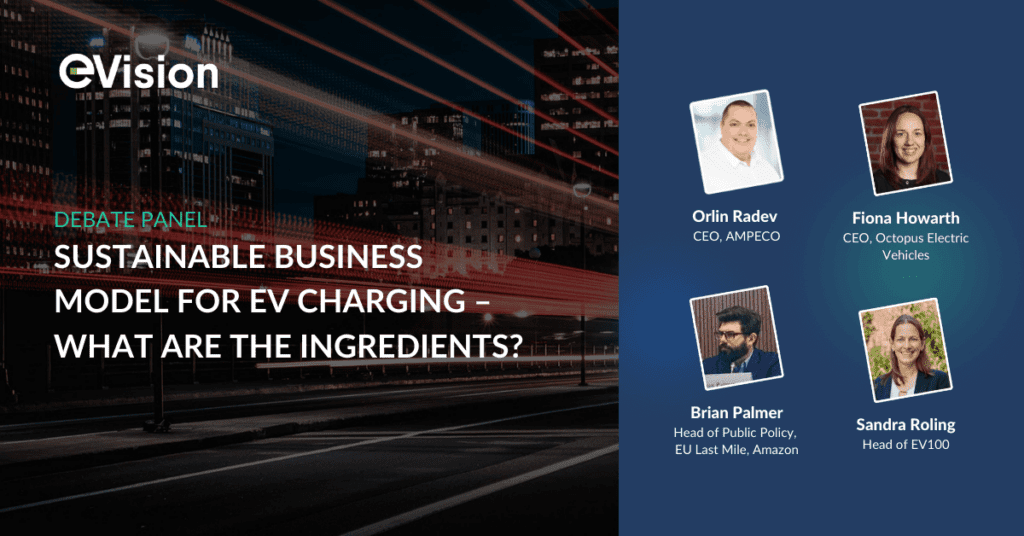Last week, Eurelectric’s EVision 2022 brought together e-mobility players from across the private, public, and power sectors for a two-day event dedicated to exploring the challenges and opportunities in accelerating transport electrification.
Orlin Radev, founder and CEO of AMPECO, took part in a panel discussion on the role businesses play in accelerating the transition to e-mobility alongside Fiona Howarth, CEO at Octopus Electric Vehicles, and Brian Palmer, Head of Public Policy at EU Last Mile, Amazon.

In brief:
- Companies should commit to electrifying their fleets and installing charging infrastructure to meet Europe’s sustainability goals.
- Smart EV charging software helps fleets manage their EV charging infrastructure and balance the energy demands on the grid.
- The grid can handle the increase in demand from EVs, but the peaks from simultaneous EV charging will present the most significant challenges to its stability.
- Flexible tariffs increase customer participation which is critical to the success of emobility.
- Data and analytics enable modeling, predictions, and optimizations that shape current and future e-mobility solutions.
Companies electrifying their fleets and installing charging infrastructure are the agents of change, accelerating the mass roll-out of EVs. The panelists explored what’s needed to continue moving EVs forward and how smart technologies can streamline the process of transition.
Turning fleets green
Fleets contribute substantially towards greenhouse emissions, and their electrification has become critical to organizations such as Amazon that want to meet sustainability goals. To that effect, Brian Palmer shared, “Our customers want us to be leaders in the fight against climate change and be leaders in sustainability.” Amazon has committed to using 100% renewable energy by 2025 and reaching net-zero carbon by 2040. Fiercely dedicated to these sustainability goals, he highlighted the many challenges companies face when electrifying their fleets.
Smart EV charging software can address these challenges
EV charging software can offer solutions to these challenges.
Fleet operators can track and plan for the electricity consumption of each vehicle while having a clear picture of the whole fleet’s energy usage. A smart software solution also allows employees to charge their EV at home and receive reimbursements for the electricity consumption by the employer.
Do EVs spell catastrophe for the grid?
Electricity demand from EV charging is expected to grow by 30% per year. Contrary to popular belief, energy specialists have concluded that the grid will cope with the exponential demand from EV drivers. However, the unpredictable peaks in demand, which will come from simultaneous charging by EV drivers, can potentially destabilize and disrupt grid operations.
Operators should rely on smart technologies that will limit the impact of charging on the grid. Smart energy management can reduce grid stress, reduce investments in upgrading grid infrastructures and mitigate potential disruptions. Smart charging, for instance, allows EV charging to occur when the grid has a surplus capacity or reduced demand by using algorithms to read grid load and shift demand. While hardware plays a vital role in power management, significant challenges require smart software solutions.
Fiona Howarth agreed, stating, “Smart technologies enable us to use the infrastructure better. In terms of the grid, we can use it in the middle of the night when the grid is underutilized.”
They also help balance the grid when there is an oversupply of green energy. V2G technology returns the energy stored in EV batteries to the grid through bi-directional charging stations, reducing the need to increase power generation to support EVs. In Octopus’s V2G trial with 130 Nissan Leafs, drivers are testing this technology and are working with the local grid to make this possible.
The panelists agreed that grids would remain stable with careful planning, even when more charging stations are connected.
CEO of @AmpecoGlobal, @orlinradev tells #EVision22:
— Eurelectric (@Eurelectric) February 9, 2022
“Advanced tech solutions [including] smart hardware and intelligent software can solve most… of the challenges you meet in charging &… increase the benefits of transitioning to #EVs.”
Tune in ?https://t.co/TU9DsPDA5C pic.twitter.com/vGXC9zM4aw
Flexible tariffs increase participation in grid management
Smart energy management allows fleet operators to profit from flexible tariffs where customers can opt-out of charging when energy demand is high and be compensated for doing so.
Time-varying tariffs incentivize load adjustment. Customers can adjust their electricity consumption voluntarily (automatically or manually) to reduce their energy expenses while benefiting the grid.
Fiona Howarth highlighted the considerable opportunity of flexible tariffs stating, “customers reduced their peak consumption by 47%” by using flexible tariffs.
Get started with AMPECO
Book a 30-min introductory call with our specialists and learn more about our EV charging platform.
Data can help optimize charging networks
Leveraging data from the charging network can provide opportunities to make predictions and provide insights to optimize transport.
Fleet operators can leverage the data accumulated from their charging stations to improve overall network reliability. Data analysis can enable proper planning of the EV charging infrastructure and determine the locations that will have the most impact, promoting EV ownership and usage.
Final thoughts: EVs are here to stay
Europe will have 130 million electric vehicles on the road by 2035 according to a joint report from EY and Eurelectric. The report’s projections show that Europe’s EV fleet will grow to 65 million (currently, less than 5 million) by 2030 and will need 65 million chargers to power them.
“We have reached the point of no return in terms of EVs” is Orlin Radev’s stance on the future of e-mobility. To keep the momentum going, we must make charging convenient and affordable while minimizing its impact on our electrical grid. Business leaders such as Amazon, who electrify their fleets, set a great example and will undoubtedly encourage others to transition to electric vehicles.
For further details and insights from the panelists, please watch the recording of the debate below.

